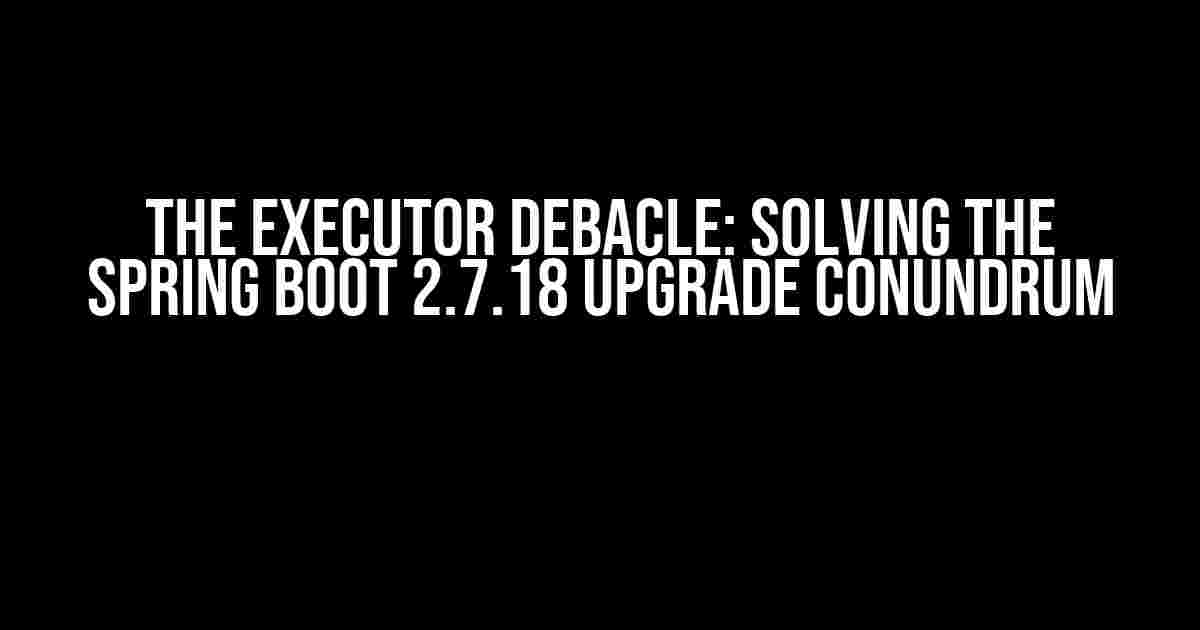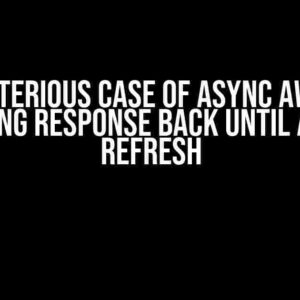Upgrading to Spring Boot 2.7.18 sounds like a breeze, right? Well, not so fast! Many developers have reported that the Executor didn’t work as expected after upgrading to this version. In this article, we’ll dive into the heart of the issue, explore the reasons behind it, and provide you with step-by-step solutions to get your Executor up and running again.
The Problem: Executor Didn’t Work After Upgrading to Spring Boot 2.7.18
Before we dive into the solutions, let’s understand the problem. After upgrading to Spring Boot 2.7.18, many developers reported that their Executor, which was working flawlessly in previous versions, suddenly stopped functioning. The error messages were cryptic, and the debugging process was a nightmare. But fear not, dear developer, for we’ve got you covered!
Why Did the Executor Stop Working?
The root cause of this issue lies in the changes made to the Executor configuration in Spring Boot 2.7.18. In this version, the default thread pool size for the Executor was changed from “unbounded” to a fixed size of 50. This change was made to improve performance and prevent resource starvation. However, it also introduced a compatibility issue with existing applications that relied on the unbounded thread pool.
Solutions to Get Your Executor Working Again
Now that we’ve identified the problem, let’s get to the solutions! We’ll provide you with two approaches to overcome this issue: configuration tweaks and code changes.
Configuration Tweaks
In this approach, we’ll make some configuration changes to tweak the Executor settings. This method is easier and more straightforward, but it might not be suitable for all scenarios.
Adjusting the Thread Pool Size
One way to resolve the issue is to adjust the thread pool size to a value that suits your application’s needs. You can do this by adding the following configuration to your application.properties file:
spring.task.execution.pool.size=<desired-thread-pool-size>
Replace <desired-thread-pool-size> with the desired thread pool size. For example:
spring.task.execution.pool.size=100
This will set the thread pool size to 100. You can adjust this value based on your application’s requirements.
Disabling the Thread Pool Size Limit
If you’re not comfortable with a fixed thread pool size, you can disable the thread pool size limit altogether. To do this, add the following configuration to your application.properties file:
spring.task.execution.pool.size=-1
This will allow the thread pool to grow dynamically, similar to the behavior in previous Spring Boot versions.
Code Changes
In this approach, we’ll make some code changes to customize the Executor configuration programmatically. This method provides more flexibility and control over the Executor settings.
Creating a Custom TaskExecutor
One way to resolve the issue is to create a custom TaskExecutor that sets the thread pool size programmatically. You can do this by creating a custom configuration class:
@Configuration
public class ExecutorConfig {
@Bean
public TaskExecutor taskExecutor() {
ThreadPoolTaskExecutor executor = new ThreadPoolTaskExecutor();
executor.setCorePoolSize(50); // set the desired thread pool size
executor.setMaxPoolSize(100); // set the maximum thread pool size
executor.setQueueCapacity(100); // set the queue capacity
return executor;
}
}
In this example, we’re creating a custom TaskExecutor that sets the thread pool size to 50, the maximum thread pool size to 100, and the queue capacity to 100. You can adjust these values based on your application’s requirements.
Using the @Async Annotation
Another way to resolve the issue is to use the @Async annotation to specify the Executor configuration for each asynchronous method. You can do this by creating a custom AsyncTaskExecutor:
@Component
public class AsyncTaskExecutor {
@Async("myExecutor")
public void executeAsyncMethod() {
// your asynchronous code goes here
}
}
In this example, we’re using the @Async annotation to specify the Executor configuration for the executeAsyncMethod(). The “myExecutor” value refers to the custom TaskExecutor bean that we created earlier.
Bonus: Troubleshooting Tips
Troubleshooting Executor issues can be frustrating, but with these tips, you’ll be better equipped to handle them:
-
Enable debug logging for the Executor by adding the following configuration to your application.properties file:
logging.level.org.springframework.core.task=DEBUG
-
Use a thread dump tool, such as VisualVM or JMC, to analyze the thread pool and identify bottlenecks.
-
Monitor the Executor’s performance using metrics, such as the number of active threads, queue size, and execution time.
Conclusion
The Executor didn’t work after upgrading to Spring Boot 2.7.18? No worries! With these solutions and troubleshooting tips, you should be able to get your Executor up and running again. Remember to adjust the thread pool size or disable the thread pool size limit to overcome the compatibility issue. Happy coding!
| Configuration Tweaks | Code Changes |
|---|---|
| Adjust thread pool size in application.properties | Create a custom TaskExecutor with programmatically set thread pool size |
| Disable thread pool size limit in application.properties | Use the @Async annotation to specify Executor configuration for each asynchronous method |
Choose the approach that best fits your needs, and don’t hesitate to reach out if you have any further questions or concerns. Happy coding, and may the Executor be with you!
SEO Keywords: Executor didn’t work, Spring Boot 2.7.18, upgrade issue, thread pool size, configuration tweaks, code changes, troubleshooting tips.
Frequently Asked Question
Got stuck while upgrading to Spring Boot 2.7.18? Don’t worry, we’ve got you covered! Here are some frequently asked questions and answers to help you troubleshoot the issues.
Why did my Executor stop working after upgrading to Spring Boot 2.7.18?
One possible reason is that the Executor configuration has changed in Spring Boot 2.7.18. Make sure you’ve updated your configuration to use the new `TaskExecutorBuilder` instead of the deprecated `ThreadPoolTaskExecutor`.
I’m getting a “No qualifying bean of type [java.util.concurrent.Executor]” error. What’s going on?
This error usually occurs when Spring can’t find a suitable Executor bean in the application context. Double-check that you’ve correctly defined and registered your Executor bean in your configuration class.
How do I configure my Executor to use the correct thread pool size in Spring Boot 2.7.18?
You can configure the thread pool size by using the `@Configuration` annotation and creating a `TaskExecutorBuilder` bean. For example, `builder.threadPoolSize(10);` will set the thread pool size to 10.
Can I still use the deprecated ThreadPoolTaskExecutor in Spring Boot 2.7.18?
While you can still use the deprecated `ThreadPoolTaskExecutor`, it’s not recommended as it may be removed in future versions of Spring Boot. Instead, migrate to the new `TaskExecutorBuilder` for better performance and compatibility.
What’s the best way to troubleshoot Executor issues in Spring Boot 2.7.18?
Enable debug logging for the `org.springframework` package to get more detailed logs about the Executor configuration and behavior. You can also use tools like VisualVM or Java Mission Control to monitor thread activity and identify bottlenecks.


